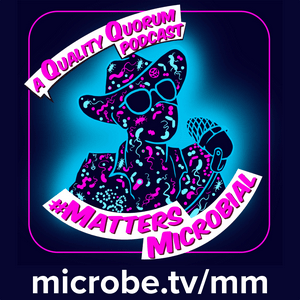Matters Microbial #101: Electrifying News about Cable Bacteria July 25, 2025 Today, Dr. Nicole Geerlings from the University of Vienna in Austria joins the #QualityQuorum to discuss some of the wonderful work she and colleagues have carried out studying the wild, weird, and wonderful world of cable bacteria, which can conduct electricity over microbially enormous distances! Definitely time for #OMG and #WTM! Host: Mark O. Martin Guest: Nicole Geerlings Subscribe: Apple Podcasts, Spotify Become a patron of Matters Microbial! Links for this episode This just became available: a wonderful short introduction to day’s topic, the cable bacteria, from Asimov Press. It is an absolute must read for everyone interested. Here is a link to the Summer Science Program, a wonderful outreach program for high school juniors. An essay about Nobel Prize winning Albert Szent-Györgyi, who stated that life was a matter of electrons finding a place to rest. Here is a short video introduction to his work. A video introduction to microbial metabolism. A video introduction to electron transport. Remember that bacteria and archaea are VERY skilled at using different electron donors and acceptors than eukaryotic life. The really fun concept of the “Jagendorf Jump,” showing electron transport vs. pH in chloroplasts. An overview of the microbial fuel cell concept. Here is a nice overview I highly recommend. A commercial source for you to build your own microbial fuel cell. A DIY approach to building a MFC. An ESSENTIAL overview to the idea of electrons in microbial sediments. A review article about cable bacteria. Here is another fine review. This is a third great introduction to cable bacteria. And here is a video overview. An article by Dr. Geerlings and colleagues describing cable bacteria for new #Micronauts. HIGHLY RECOMMENDED. An review of stable isotope probing in microbiology. Here is a video seminar using SIP in microbiology. An overview of Nano-SIMS and how it is used in microbiology. Here is another review. A deeply wonderful article by Dr. Geerlings and colleagues suggesting that inactive cells with the “microbial cable” are still conducting electrons! Dr. Geerlings postdoctoral scholar website. Links and References on Cable Bacteria from Dr. Geerlings: 1. Here is a website from the group of Prof. Dr. Filip Meysman from the University of Antwerp, which includes a great video on the electron conductivity of cable bacteria. 2. The first paper describing redox half-reactions separated by long-distance electron transport. Nielsen, L. P., Risgaard-Petersen, N., Fossing, H., Christensen, P. B., and Sayama, M. (2010). Electric currents couple spatially separated biogeochemical processes in marine sediment. Nature 463, 1071–1074. doi: 10.1038/nature08790 3. The paper describing the discovery of cable bacteria. Look into the supplemental material for the excellent experimental set-up to prove that the cable bacteria are the ones doing the long-distance electron transport. Pfeffer, C., Larsen, S., Song, J., Dong, M., Besenbacher, F., Meyer, R. L., et al. (2012). Filamentous bacteria transport electrons over centimetre distances. Nature 491, 218–221. Doi: 10.1038/nature11586 4. A paper that dives into the conductivity of the cable bacteria network and shows that these fibres can conduct electrons just as well as a copper wire. Meysman, F. J. R., Cornelissen, R., Trashin, S., Bonné, R., Martinez, S. H., van der Veen, J., et al. 2019. A highly conductive fibre network enables centimetre-scale electron transport in multicellular cable bacteria. Nat. Commun. 10:1–8. doi: 10.1038/s41467-019-12115-7 5. This paper describes how cable bacteria activity generates a layer of iron oxyhydroxides on the top of the sediment layer and how this delays the release of sulfide into the water column for several weeks in a seasonally hypoxic basin in the Netherlands. Seitaj, D., R. Schauer, F. Sulu-Gambari, et al. 2015. “Cable Bacteria Generate a Firewall Against Euxinia in Seasonally Hypoxic Basins.” Proceedings of the National Academy of Sciences of the United States of America 112: 13278–13283. 6. This paper describes how the catabolic division of labor is coupled to an anabolic division of labor where cells reducing oxygen cannot grow and therefore provide a “community service” for the rest of the filament. Nicole M. J. Geerlings, Cheryl Karman, Stanislav Trashin, Karel S. As, Michiel V. M. Kienhuis, Silvia Hidalgo-Martinez, Diana Vasquez-Cardenas, Henricus T.S. Boschker, Karolien de Wael, Jack J. Middelburg, Lubos Polerecky, and Filip J.R. Meysman. Division of labor and growth during electrical cooperation in multicellular cable bacteria. Proc. Natl. Acad. Sci. U.S.A. 117, 5478–5485. Doi: 10.1073/pnas.1916244117 Intro music is by Reber Clark Send your questions and comments to
[email protected] 

